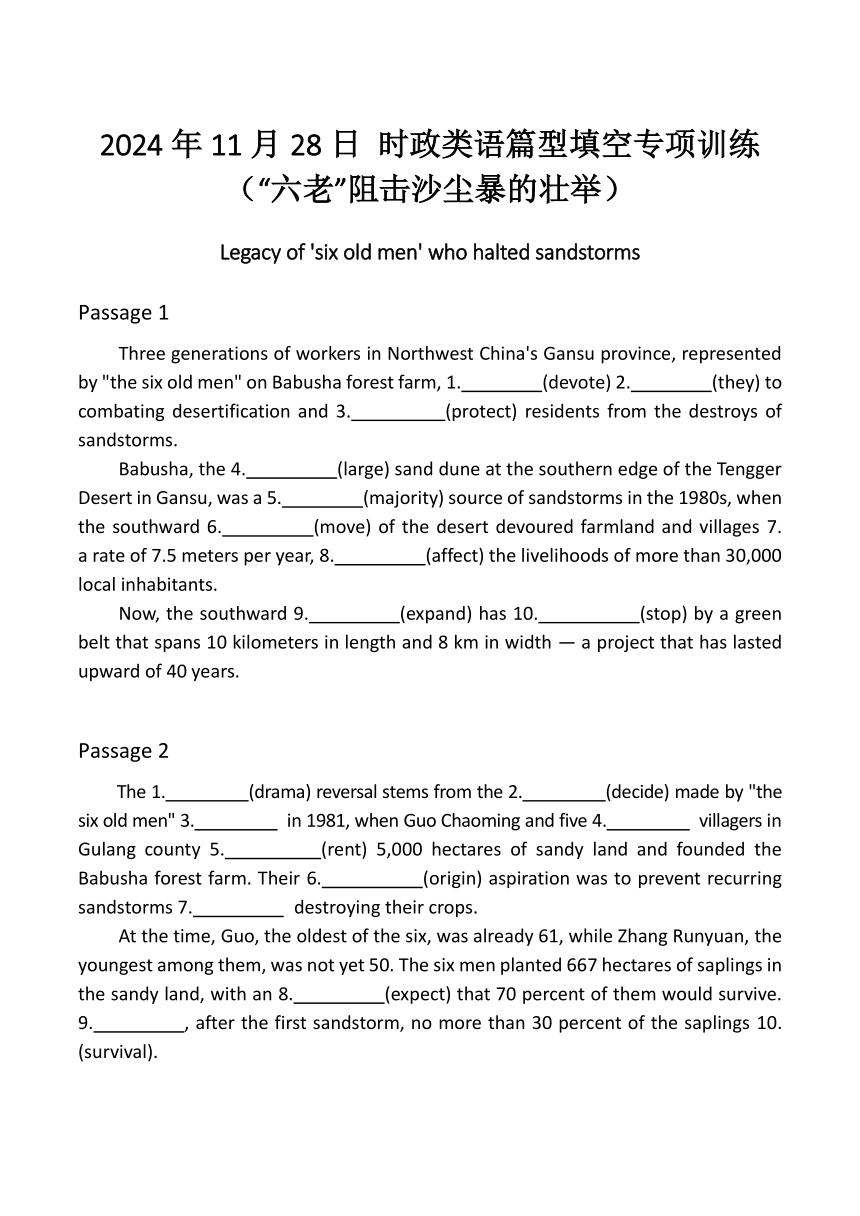
2024年11月28日 时政类语篇型填空专项训练(“六老”阻击沙尘暴的壮举) Legacy of 'six old men' who halted sandstorms Passage 1 Three generations of workers in Northwest China's Gansu province, represented by "the six old men" on Babusha forest farm, 1. (devote) 2. (they) to combating desertification and 3. (protect) residents from the destroys of sandstorms. Babusha, the 4. (large) sand dune at the southern edge of the Tengger Desert in Gansu, was a 5. (majority) source of sandstorms in the 1980s, when the southward 6. (move) of the desert devoured farmland and villages 7. a rate of 7.5 meters per year, 8. (affect) the livelihoods of more than 30,000 local inhabitants. Now, the southward 9. (expand) has 10. (stop) by a green belt that spans 10 kilometers in length and 8 km in width — a project that has lasted upward of 40 years. Passage 2 The 1. (drama) reversal stems from the 2. (decide) made by "the six old men" 3. in 1981, when Guo Chaoming and five 4. villagers in Gulang county 5. (rent) 5,000 hectares of sandy land and founded the Babusha forest farm. Their 6. (origin) aspiration was to prevent recurring sandstorms 7. destroying their crops. At the time, Guo, the oldest of the six, was already 61, while Zhang Runyuan, the youngest among them, was not yet 50. The six men planted 667 hectares of saplings in the sandy land, with an 8. (expect) that 70 percent of them would survive. 9. , after the first sandstorm, no more than 30 percent of the saplings 10. (survival). Passage 3 Through trial and error, the men 1. (discovery) that saplings planted near grass clumps had a 2. (high) survival rate. The 3. (follow) year, they 4. (bury) wheat straw around the tree pits to fix the sand, thereby successfully 5. (improve) the sapling survival rate. And this approach — using a tree and a handful of grass to hold the sand and prevent wind erosion — became one of the most cost-effective and 6. (practice) technologies for desertification control in China. Planting trees in the desert is difficult, but 7. (maintain) them is even harder. 8. (protect) the trees they had painstakingly planted, the six men lived and worked on the site 9. years. They dug a pit in the sand, propped it up with wooden poles, and covered it with straw to create a rudimentary shelter. They used bricks to support a cooking pot, 10. (drink) boiled water and ate steamed buns when hungry. Passage 4 Their living conditions didn't improve 1. 1983, when they 2. (build) three rooms nearby with the help from the local forestry bureau. In the eyes of the six men, the Babusha forest farm became their most precious 3. (possess). Even in the 1990s, when they faced 4. (finance) difficulties and had no source of income, they couldn't bring themselves to cut 5. a single tree or pull up a single blade of grass 6. (trade) for money. Two of the six died of 7. (ill) in 1991 and 1992. In 2005 and 2018, two others passed away. Their children and grandchildren took up the torch and have carried 8. the unfin ... ...
~~ 您好,已阅读到文档的结尾了 ~~

